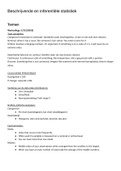Class notes
Aantekeningen Beschrijvende en Inferentiële Statistiek
- Course
- Institution
Dit is een samenvatting van de colleges en de kennisclips van Beschrijvende en Inferentiële Statistiek bij de VU. Alle stof van module 0 tot 13 komt hier aan bod. Ik had een 7 voor dit tentame.
[Show more]



